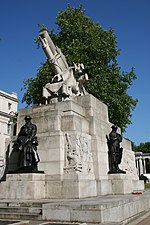The Lanesborough
1991 establishments in EnglandBuildings and structures in Hyde Park, LondonEngvarB from September 2018Grade II* listed buildings in the City of WestminsterGrade II* listed hotels ... and 8 more
Hotels established in 1991Hotels in the City of WestminsterInfrastructure completed in 1844Michelin Guide starred restaurants in the United KingdomNeoclassical architecture in LondonOetker CollectionSt George's, University of LondonThe Leading Hotels of the World

The Lanesborough is a 5-star hotel on Hyde Park Corner in Knightsbridge, central London, England. The hotel is operated by the Oetker Collection. It is in neoclassical style and is listed Grade II*.Opposite are Hyde Park and Apsley House, the London home of the Dukes of Wellington. The hotel is next to Hyde Park Corner tube station.
Excerpt from the Wikipedia article The Lanesborough (License: CC BY-SA 3.0, Authors, Images).The Lanesborough
Grosvenor Place, London Belgravia
Geographical coordinates (GPS) Address External links Nearby Places Show on map
Geographical coordinates (GPS)
| Latitude | Longitude |
|---|---|
| N 51.5025 ° | E -0.1525 ° |
Address
The Lanesborough
Grosvenor Place
SW1X 7TA London, Belgravia
England, United Kingdom
Open on Google Maps











